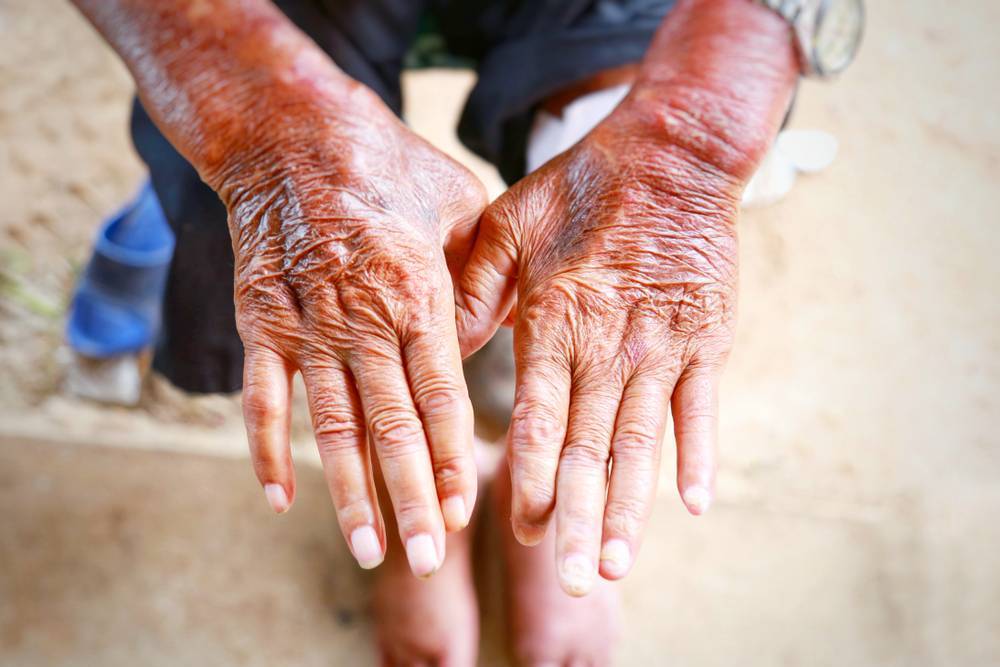What is Scleroderma?
Scleroderma is a chronic, rare autoimmune rheumatic connective tissue disease characterised by degenerative changes in the texture and appearance of the skin, connective tissue, and internal organs. The immune system produces an excess of collagen in the skin, which leads to thick scarring (fibrosis) of the skin. Scleroderma also affects the muscles, heart, lungs, digestive system, blood vessels and kidneys.
Vascular dysfunction can also manifest where blood vessels thicken over time, leading to tissue damage and high blood pressure. Scleroderma is not infectious and cannot spread from one person to another. Scleroderma can be classified into localised scleroderma or systemic scleroderma.
Systemic Sclerosis
Systemic sclerosis is a generalised type of scleroderma that involves multiple organs or systems.
Aetiology
Systemic sclerosis is 4 times more common in women than in men and is common between the ages of 20 to 50. Systemic sclerosis symptoms may occur as a part of mixed connective tissue disease.
The two clinical subsets for systemic sclerosis can be categorised as limited scleroderma and diffuse scleroderma.
Limited cutaneous systemic sclerosis (limited scleroderma)
Limited scleroderma mainly affects the skin where there is skin thickening distal to elbows and knees, which may also include the face and neck. It is also known as CREST syndrome, a limited form of the disorder that encompasses a myriad of these symptoms:
- Calcinosis cutis: Calcium deposits and forms nodules in the organs or under the skin.
- Raynaud’s phenomenon: Lack of blood flow to certain parts of the body, especially the extremities such as the toes, nose and fingers.
- Oesophageal dysmotility
- Sclerodactyly: Thickening of the skin which causes dysfunction in motility in the fingers and toes
- Telangiectasia (Spider Veins)
This occurs when tiny dilated or broken blood vessels start surfacing near the surface of the skin or mucous membranes.
Patients with this disease develop skin tightening over their limbs, hands, feet and face. The disease is slow but can progress to the later onset of pulmonary arterial hypertension (PAH), where the blood pressure of the arteries in the lungs becomes abnormally high.
Diffuse cutaneous systemic sclerosis (diffuse scleroderma)
Diffuse scleroderma, on the other hand, causes skin thickening and damage to proximal and distal elbows and knees, trunk and is widespread throughout the body. This is a more serious form of systemic sclerosis where there is a rapid progression in the disease.
People with the disease suffer from Raynaud’s phenomenon, where there is decreased blood flow to the fingers and can also cause spasms in the extremities of nerve endings in the ears, knees or nose, triggered by cold or stress. In some patients, there may also be an early development of interstitial lung disease (ILD) and lung fibrosis that affect the air sacs of the lung, making it harder to breathe. These patients also face an increased risk of renal crisis and cardiac diseases.
Symptoms of Systemic Sclerosis
The initial symptoms include:
- Swelling, thickening and tightening of the skin at the ends of the fingers
- Raynaud’s phenomenon (80% of patients) and ulcers on fingers and toes (digital ulcers)
- Heartburn
- Shortness of breath
- Inflammation of the muscles (myositis) and aches and pain in joints
Skin Changes
Large areas of the skin may be damaged but most of the disorder is limited to the hands. The skin starts to become tight, shiny and dark, some patients will also start having trouble controlling their facial expressions.
Gastrointestinal Tract Changes
The most common change in patients happens in the lower end of the oesophagus due to nerve damage and scarring. This often results in oesophageal reflux and swallowing difficulties. Barrett’s oesophagus occurs is a type of oesophageal cancer that occurs in one-third of patients due to damage by acid reflux that results in abnormal cell growth, eventually obstructing the passage of food in the oesophagus.
Diagnosis of Systemic Sclerosis
Clinical features
- Skin changes, gastrointestinal, lung and heart problems
- Imaging tests: X-rays and CT scans of the lungs to look for the presence of damage
- Lung (pulmonary) function tests to screen for pulmonary hypertension or interstitial lung disease
- Raynaud’s phenomenon
- Analysis of the urine
- Skin biopsies
- Blood tests for auto-antibody testing, rheumatoid factors and sedimentation rate
Serology
Test results vary greatly between patients but antinuclear antibodies (ANA) screen can help to detect antinuclear antibodies present in up to 90% of patients with systemic sclerosis. In people with limited systemic sclerosis, an antibody to centromeres is often found. On the other hand, antibodies such as anti-topoisomerase and RNA polymerase III are usually found in patients with diffuse systemic sclerosis.
Complications of Scleroderma
Complications include high blood pressure, kidney failure, cancer, scarring (fibrosis) of the lungs, muscle inflammation and heart failure.
Management of Scleroderma
There is no known way to prevent or treat systemic sclerosis, but proper management of symptoms can help to reduce organ damage and slow disease progression.
Managing scleroderma symptoms:
- Nonsteroidal anti-inflammatory drugs (NSAIDs) help with pain management and swelling. However, these drugs are not administered to those with chronic kidney disease or gastrointestinal ulceration.
- Steroids slow the immune system and help with muscle, joint, and internal organ problems
- Blood pressure medication
- Medication to increase blood flow to the extremities and to open blood vessels in the lungs and intestines
- Immunosuppressive drugs such as mycophenolate mofetil
- Heartburn medication such as antacids and proton pump inhibitors prevent excessive secretion of gastrointestinal acid
- Surgical dilation of the oesophagus
- Nitro-glycerine to help to counter tightened areas of the skin
- Lifestyle changes: smoking cessation and eating healthily to avoid heartburn
- Stress management
- Occupational and physical therapy to maintain muscle strength
Conclusion
Systemic sclerosis is a complicated autoimmune disease that cannot be prevented. In general, the prognosis is better in patients with limited systemic sclerosis than in patients with diffuse systemic sclerosis.

